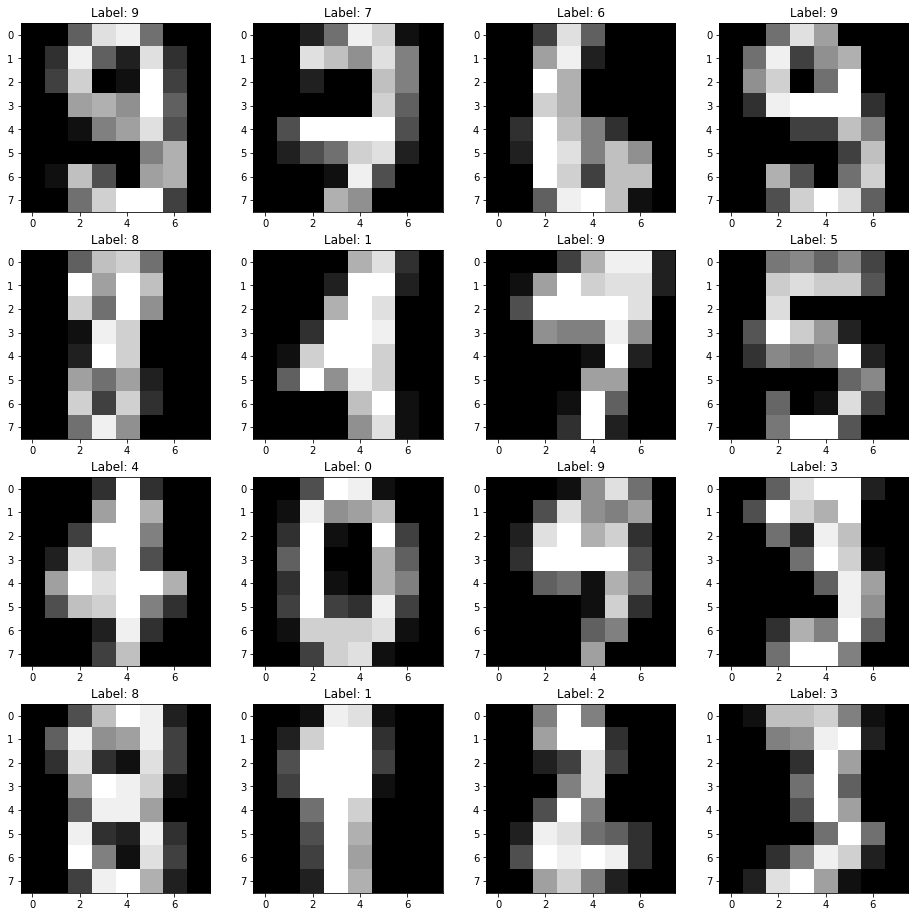7.1. Softmax classification¶
In this exercise, you will implement a softmax classifier for multi-class classification.
import numpy as np
import matplotlib.pyplot as plt
7.1.1. Loading the data¶
Let’s now import the digits dataset provided by scikit-learn:
https://scikit-learn.org/stable/modules/generated/sklearn.datasets.load_digits.html
It contains 1797 small (8x8) black and white images of digits between 0 and 9.
The two following cells load the data and visualize 16 images chosen randomly.
from sklearn.datasets import load_digits
digits = load_digits()
N, w, h = digits.images.shape
d = w * h # number of pixels
c = len(digits.target_names) # number of classes
rng = np.random.default_rng()
indices = rng.choice(N, 16)
plt.figure(figsize=(16, 16))
for i in range(16):
plt.subplot(4, 4, i+1)
plt.imshow(digits.images[indices[i], :], cmap="gray")
plt.title("Label: "+ str(digits.target[indices[i]]))
plt.show()

Digits are indeed to be recognized, the hope being that they are linearly separable and we can apply a softmax classifier directly on the pixels.
The only problem is that each image is a 8x8 matrix, while we want vectors for our model. Fortunately, that is very easy with reshape:
X = digits.images.reshape((N, d))
print(X.shape)
(1797, 64)
Let’s know have a look at the targets, i.e. the ground truth / labels of each digit:
labels = digits.target
print(labels)
print(labels.shape)
[0 1 2 ... 8 9 8]
(1797,)
Each label is an integer between 0 and 9, while our softmax classifier expects a one-hot-encoded vector of 10 classes, with only one non-zero element, for example for digit 3:
To do the conversion, we can once again use a built-in method of scikit-learn:
from sklearn.preprocessing import OneHotEncoder
t = OneHotEncoder().fit_transform(labels.reshape(-1, 1)).toarray()
print(t)
print(t.shape)
[[1. 0. 0. ... 0. 0. 0.]
[0. 1. 0. ... 0. 0. 0.]
[0. 0. 1. ... 0. 0. 0.]
...
[0. 0. 0. ... 0. 1. 0.]
[0. 0. 0. ... 0. 0. 1.]
[0. 0. 0. ... 0. 1. 0.]]
(1797, 10)
Q: Split the data into a training set X_train, t_train and a test set X_test, t_test using scikit-learn (e.g. with a ratio 70/30).
7.1.2. Softmax linear classifier¶
Let’s remember the structure of the softmax linear classifier: the input vector \(\mathbf{x}\) is transformed into a logit score vector \(\mathbf{z}\) using a weight matrix \(W\) and a bias vector \(\mathbf{b}\):
This logit score has one element per class, so the weight matrix must have a size \((c, d)\), where \(c\) is the number of classes (10) and \(d\) is the number of dimensions of the input space (64). The bias vector has 10 elements (one per class).
The logit score is turned into probabilities using the softmax operator:
The following Python function allows to turn any vector \(\mathbf{z}\) (numpy array) into softmax probabilities:
def softmax(z):
e = np.exp(z - z.max())
return e/np.sum(e)
Q: Experiment with the softmax() to understand its function. Pass it different numpy arrays (e.g. [-1, 0, 2]) and print or plot the corresponding probabilities.
The loss function to use is the cross-entropy or negative log-likelihood, defined for a single example as:
where \(\mathbf{t}\) is a one-hot encoding of the class of the example and \(j\) is the index of the corresponding class.
After doing the derivations, we obtain the following learning rules for \(W\) and \(\mathbf{b}\) to minimize the loss function:
Note that because \(W\) is a \((c, d)\) matrix, \(\Delta W\) too. \((\mathbf{t} - \mathbf{y}) \, \mathbf{x}^T\) is therefore the outer product between the error vector \(\mathbf{t} - \mathbf{y}\) (\(c\) elements) and the input vector \(\mathbf{x}\) (\(d\) elements).
7.1.3. Implementation¶
You will now modify your implementation of the online Perceptron algorithm from last week.
Some things to keep in mind:
Wmust now be defined as a \((c, d)\) matrix (numpy array) andbas a vector with \(c\) elements. Both can be initialized to 0.When computing the logit score \(\mathbf{z} = W \times \mathbf{x} + \mathbf{b}\), remember that
Wis now a matrix, so its position will matter in the dot productnp.dot.Use the
softmax()function defined above on the whole vector instead ofnp.sign()orlogisticto get the prediction \(\mathbf{y}\).For \(\Delta W\), you will need the outer product between the vectors \(\mathbf{t} - \mathbf{y}_\text{train}\) and \(\mathbf{x}_\text{train}\). Check the doc for
np.outer().The one-hot encoding of the class of the example \(i\) is now a vector with 10 elements
t_train[i, :]. You can get the index of the corresponding class by looking at the position of its maximum witht_train[i, :].argmax().Similarly, the predicted class by the model can be identified by the class with the maximum probability:
y.argmax().Do not forget to record and plot the evolution of the training error and loss. Compute the test error and loss at the end of learning.
Pick the right learning rate and number of epochs.
Q: Let’s go.
Q: What is the final training error and loss of the model? After how many epochs do you get a perfect classification? Why do they evolve like this?
Hint: you may need to avoid plotting the error/loss during the first 20 epochs or so to observe the effect.
Q: Compare the evolution of the training and test errors during training. What happens?
Q: The following cell samples 12 misclassified images from the test and shows the predicted class together with the ground truth. What do you think?
misclassified = []
for i in range(N_test):
c = softmax(np.dot(W, X_test[i, :]) + b).argmax()
if c != t_test[i, :].argmax():
misclassified.append([X_test[i, :].reshape((8, 8)), t_test[i, :].argmax(), c])
if len(misclassified) > 12: break
plt.figure(figsize=(16, 12))
for i in range(12):
if i < len(misclassified):
X, t, c = misclassified[i]
plt.subplot(3, 4, i+1)
plt.imshow(X, cmap="gray")
plt.title("Label " + str(t) + " ; Prediction " + str(c))
plt.show()